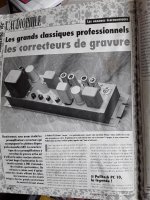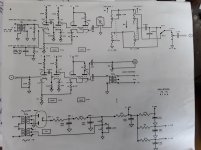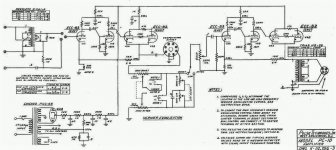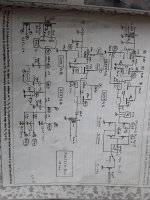merlin, I would not use resistors to load the tubes. you might consider CCS' and remove the output autotrafo (to be replaced by a follower) to save money but it would be something really different
Ciao Gianluca,
Yes I see you use anode choke in place of resistor but I don't have and want to know the resistors values, I guess only CCS for 6DJ8/ECC88: do you know how many mA?
I have also the AVC from Intact Audio as passive preamp.
Saluti
Felipe
I see and I think is interesting, did you make to know how it sounds?
Ciao Gianluca,
Yes I see you use anode choke in place of resistor but I don't have and want to know the resistors values, I guess only CCS for 6DJ8/ECC88: do you know how many mA?
I have also the AVC from Intact Audio as passive preamp.
Saluti
Felipe
15mA for D3A, 10mA for ECC88
I have not made the Millett, I currently have 3 phono preamp projects in various stages of completion, I really shouldn't add another!
BUT, that circuit is incredibly interesting and compelling. If I didn't have 2 SYclotron designs and a Salas to build, I'd start the Millett tomorrow.
Look at the PowerPoint presentation he gave at European Triode Fest, it's the first links on his page, or click here - http://www.pmillett.com/file_downloads/LR Phono Preamps.pdf
BUT, that circuit is incredibly interesting and compelling. If I didn't have 2 SYclotron designs and a Salas to build, I'd start the Millett tomorrow.
Look at the PowerPoint presentation he gave at European Triode Fest, it's the first links on his page, or click here - http://www.pmillett.com/file_downloads/LR Phono Preamps.pdf
15mA for D3A, 10mA for ECC88
Grazie Gianluca
I have not made the Millett, I currently have 3 phono preamp projects in various stages of completion, I really shouldn't add another!
BUT, that circuit is incredibly interesting and compelling. If I didn't have 2 SYclotron designs and a Salas to build, I'd start the Millett tomorrow.
Look at the PowerPoint presentation he gave at European Triode Fest, it's the first links on his page, or click here - http://www.pmillett.com/file_downloads/LR Phono Preamps.pdf
Thanks for the link 6L6.
I see and I think is interesting, did you make to know how it sounds?
I finished building one last weekend, it sounds excellent!
I finished building one last weekend, it sounds excellent!
I guess is SS, have you compared the subjective sound quality vs LCR?
I guess is SS, have you compared the subjective sound quality vs LCR?
Yes it is solid state, read posts #83 and #87 and follow the links to the design and EF2013 presentation by Pete Millett, and read his comments on his web site.
No capactiors in the direct sgnal path. RIAA EQ using resistors and EQ pot core inductors only.
No, I have not compared the subjective sound quality with LCR RIAA as I don't have a phono with LCR RIAA. However I can say the superb bass resolution is the oustanding factor in this design.
With regard to the famous Thorsten Loesch LCR phono preamp that is refenced in this thread, I have a few questions.
1) The schematic for this unit shows the 100 nf Mica-Mold DC blocking capacitor at the output of the LCR EQ network. As such, full B+ voltage from the plate of the input tube appears at the input of the LCR network.
Wouldn't it make more sense to locate this capacitor at the input to the LCR EQ network? Doing so would eliminate the possibility of the LCR network failing due to the stress of having the B+ appear at the input pole of the network. Unless I am missing something here, what was the logic of locating this blocking capacitor at the output of the LCR network? My guess is that locating this capacitor at the network input would require a significantly larger value capacitor, perhaps on the order of 10 uf or so, to account for the low input impedance requirement (600 ohms) required by the LCR EQ.
2) What is the approximate output impedance presented by this circuit? I'm sure it is relatively low, but an approximation of the output Z of the D3A plate follower output stage would be helpful. It would be used to drive the input to my transformer volume control unit.
Thanks & Regards,
Bruce
1) The schematic for this unit shows the 100 nf Mica-Mold DC blocking capacitor at the output of the LCR EQ network. As such, full B+ voltage from the plate of the input tube appears at the input of the LCR network.
Wouldn't it make more sense to locate this capacitor at the input to the LCR EQ network? Doing so would eliminate the possibility of the LCR network failing due to the stress of having the B+ appear at the input pole of the network. Unless I am missing something here, what was the logic of locating this blocking capacitor at the output of the LCR network? My guess is that locating this capacitor at the network input would require a significantly larger value capacitor, perhaps on the order of 10 uf or so, to account for the low input impedance requirement (600 ohms) required by the LCR EQ.
2) What is the approximate output impedance presented by this circuit? I'm sure it is relatively low, but an approximation of the output Z of the D3A plate follower output stage would be helpful. It would be used to drive the input to my transformer volume control unit.
Thanks & Regards,
Bruce
Last edited:
2) What is the approximate output impedance presented by this circuit? I'm sure it is relatively low, but an approximation of the output Z of the D3A plate follower output stage would be helpful.
It is the D3A Rp in parallel with the plate load resistor, so perhaps around 2k.
As for the coupling cap position i personally would not want my film caps to pass a low level AC signal in the presence of a significant polarising voltage, as their microphony is increased. Otoh a large coupling cap is a PITA and really expensive, so choose the lesser evil
Thanks very much for your guidance.
A 2000 ohm output Z is a little high for driving the input to my transformer volume control. If the D3A output tube was transformer-coupled to the outside world, that would be ideal, although I'd lose a lot of the gain within this circuit by doing so.
I really think the logic for the location of the 100 nf DC blocking/coupling capacitor at the output of the LCR EQ network was to allow the use of a much more smaller (and probably better sounding) capacitor. As I had indicated in my original post, I suspect that if the capacitor was located at the input of the LCR network, the value would have to increase substantially, to possibly something on the order of 10 uf or so, and finding a really good sounding capacitor of this value is not an easy task.
I am still concerned with the possibility of stressing or overvoltaging the capacitors internal to my Stevens & Billington LCR network, by having the full plate voltage of the input tube applied to them, by virtue of the location of this DC blocking capacitor. I doubt if the capacitors S & B used within their EQ600 network are rated for much above 200 VDC or so. I should check with them to see if they will share the voltage ratings of these capacitors.
Best Regards,
Bruce
A 2000 ohm output Z is a little high for driving the input to my transformer volume control. If the D3A output tube was transformer-coupled to the outside world, that would be ideal, although I'd lose a lot of the gain within this circuit by doing so.
I really think the logic for the location of the 100 nf DC blocking/coupling capacitor at the output of the LCR EQ network was to allow the use of a much more smaller (and probably better sounding) capacitor. As I had indicated in my original post, I suspect that if the capacitor was located at the input of the LCR network, the value would have to increase substantially, to possibly something on the order of 10 uf or so, and finding a really good sounding capacitor of this value is not an easy task.
I am still concerned with the possibility of stressing or overvoltaging the capacitors internal to my Stevens & Billington LCR network, by having the full plate voltage of the input tube applied to them, by virtue of the location of this DC blocking capacitor. I doubt if the capacitors S & B used within their EQ600 network are rated for much above 200 VDC or so. I should check with them to see if they will share the voltage ratings of these capacitors.
Best Regards,
Bruce
In February 2005 Kuei Yang Wang (= Thorsten Loesch) started a thread on this forum called "Designing a Phonostage with the S&B 10K LCR RIAA Module. In a post on February 6 he wrote: "The S&B RIAA contains capacitors with 630V or more DC rating in all shunt path, so it will withstand quite a bit of DC offset, as long as no DC current flows.
Therefore, if your source can be made to have 600 Ohm net impedance you can couple the S&B RIAA (and only the S&B one) directly and place the coupling cap AFTER the 600R RIAA, making it's value uncritical."
Therefore, if your source can be made to have 600 Ohm net impedance you can couple the S&B RIAA (and only the S&B one) directly and place the coupling cap AFTER the 600R RIAA, making it's value uncritical."
This is great information! Thank you very much for your help here.
The fact that the shunt capacitors within the S & B 600 ohm LCR EQ network are rated at 630 V or higher, makes me feel much better about locating the DC blocking/coupling capacitor at the output of the network. I had no idea these capacitors would be rated at that voltage, nor did I know that Thorsten was involved with the design of this network. That said, he must have obviously envisioned the S & B 600 ohm version of the EQ being used in an application where it would be required to support a reasonable plate voltage at it's input.
Based upon your suggestion to visit the link where Thorsten described an earlier iteration of his circuit, I found the following comment from him:
"The LCR made by S&B uses certain capacitors which I did specify and which are still used in production. These are quite high voltage in the 600R LCR (630V DC or higher). These capacitors are located between ground and the LR circuitry....."
Now the issue I have involves adding an additional stage with a plate-to-line transformer, so this phono preamp can easily drive the low impedance input to the my transformer volume control. I refuse to use cathode followers in any of my audio creations, due to their less than stellar sonics.
Best Regards,
Bruce
The fact that the shunt capacitors within the S & B 600 ohm LCR EQ network are rated at 630 V or higher, makes me feel much better about locating the DC blocking/coupling capacitor at the output of the network. I had no idea these capacitors would be rated at that voltage, nor did I know that Thorsten was involved with the design of this network. That said, he must have obviously envisioned the S & B 600 ohm version of the EQ being used in an application where it would be required to support a reasonable plate voltage at it's input.
Based upon your suggestion to visit the link where Thorsten described an earlier iteration of his circuit, I found the following comment from him:
"The LCR made by S&B uses certain capacitors which I did specify and which are still used in production. These are quite high voltage in the 600R LCR (630V DC or higher). These capacitors are located between ground and the LR circuitry....."
Now the issue I have involves adding an additional stage with a plate-to-line transformer, so this phono preamp can easily drive the low impedance input to the my transformer volume control. I refuse to use cathode followers in any of my audio creations, due to their less than stellar sonics.
Best Regards,
Bruce
Last edited:
Hi
I would suggest 10K network. Because these 600R is hard to drive by the tube buffers.
I know about one brand from Germany making individual inductors for RLC nets. I will try to find and post the link. As I am remember the prices are significantly smaller than others 10K at the market. Try to avoid srpp gain topolies...
I would suggest 10K network. Because these 600R is hard to drive by the tube buffers.
I know about one brand from Germany making individual inductors for RLC nets. I will try to find and post the link. As I am remember the prices are significantly smaller than others 10K at the market. Try to avoid srpp gain topolies...
Therefore, if your source can be made to have 600 Ohm net impedance you can couple the S&B RIAA (and only the S&B one) directly and place the coupling cap AFTER the 600R RIAA, making it's value uncritical."
This is essentially what I have done with the stage I built, but with a 6k2 impedance. As I had a power supply which could supply heaters at 45V above earth, I made the first stage an ECC88 cascode with a 6k2 load resistor. Other people have used D3A or E180F pentode first stages as well. The resistor after the stage can be of the order of 470k and you get a lot more gain than with the standard approach.
This is essentially what I have done with the stage I built, but with a 6k2 impedance. As I had a power supply which could supply heaters at 45V above earth, I made the first stage an ECC88 cascode with a 6k2 load resistor. Other people have used D3A or E180F pentode first stages as well. The resistor after the stage can be of the order of 470k and you get a lot more gain than with the standard approach.
Hi there MrKettle,
Would you like to share the design or parts of... I’m very interested in LRC RIAA and I would like to use triode cascodes as much as possible (personal preference). I have played with ltspice last night and concluded that a 6k approach is the best compromise (in a simulation). The problem with 6k aproach is I can’t find the coils anywhere.
Regards,
Silviu
- Home
- Source & Line
- Analogue Source
- Looking for the best SQ Phono LCR schematic




